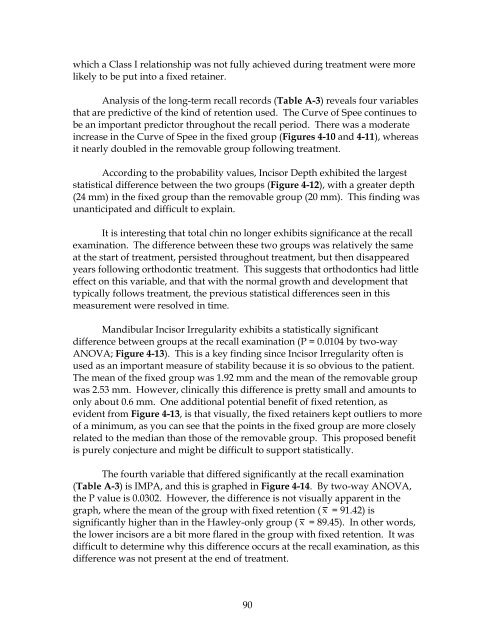EFFICACY OF TEMPORARY FIXED RETENTION FOLLOWING ...
EFFICACY OF TEMPORARY FIXED RETENTION FOLLOWING ...
EFFICACY OF TEMPORARY FIXED RETENTION FOLLOWING ...
You also want an ePaper? Increase the reach of your titles
YUMPU automatically turns print PDFs into web optimized ePapers that Google loves.
which a Class I relationship was not fully achieved during treatment were more<br />
likely to be put into a fixed retainer.<br />
Analysis of the long-term recall records (Table A-3) reveals four variables<br />
that are predictive of the kind of retention used. The Curve of Spee continues to<br />
be an important predictor throughout the recall period. There was a moderate<br />
increase in the Curve of Spee in the fixed group (Figures 4-10 and 4-11), whereas<br />
it nearly doubled in the removable group following treatment.<br />
According to the probability values, Incisor Depth exhibited the largest<br />
statistical difference between the two groups (Figure 4-12), with a greater depth<br />
(24 mm) in the fixed group than the removable group (20 mm). This finding was<br />
unanticipated and difficult to explain.<br />
It is interesting that total chin no longer exhibits significance at the recall<br />
examination. The difference between these two groups was relatively the same<br />
at the start of treatment, persisted throughout treatment, but then disappeared<br />
years following orthodontic treatment. This suggests that orthodontics had little<br />
effect on this variable, and that with the normal growth and development that<br />
typically follows treatment, the previous statistical differences seen in this<br />
measurement were resolved in time.<br />
Mandibular Incisor Irregularity exhibits a statistically significant<br />
difference between groups at the recall examination (P = 0.0104 by two-way<br />
ANOVA; Figure 4-13). This is a key finding since Incisor Irregularity often is<br />
used as an important measure of stability because it is so obvious to the patient.<br />
The mean of the fixed group was 1.92 mm and the mean of the removable group<br />
was 2.53 mm. However, clinically this difference is pretty small and amounts to<br />
only about 0.6 mm. One additional potential benefit of fixed retention, as<br />
evident from Figure 4-13, is that visually, the fixed retainers kept outliers to more<br />
of a minimum, as you can see that the points in the fixed group are more closely<br />
related to the median than those of the removable group. This proposed benefit<br />
is purely conjecture and might be difficult to support statistically.<br />
The fourth variable that differed significantly at the recall examination<br />
(Table A-3) is IMPA, and this is graphed in Figure 4-14. By two-way ANOVA,<br />
the P value is 0.0302. However, the difference is not visually apparent in the<br />
graph, where the mean of the group with fixed retention ( x = 91.42) is<br />
significantly higher than in the Hawley-only group ( x = 89.45). In other words,<br />
the lower incisors are a bit more flared in the group with fixed retention. It was<br />
difficult to determine why this difference occurs at the recall examination, as this<br />
difference was not present at the end of treatment.<br />
90
















